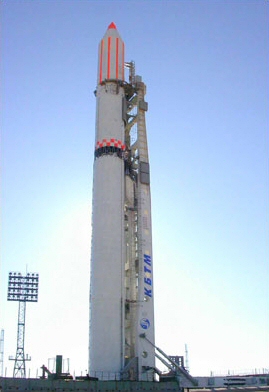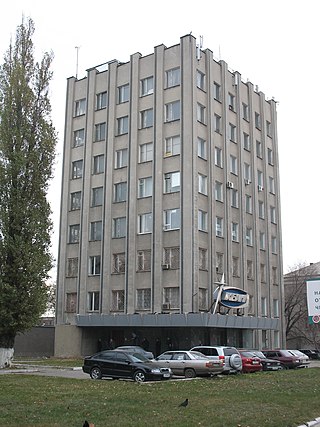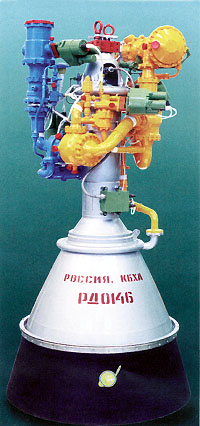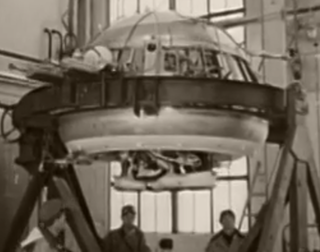Related Research Articles

Soyuz is a family of Soviet and later Russian expendable medium-lift launch vehicles initially developed by the OKB-1 design bureau and manufactured by the Progress Rocket Space Centre factory in Samara, Russia. It holds the record for the most launches in the history of spaceflight. Soyuz rockets are part of the R-7 rocket family, which evolved from the R-7 Semyorka, the world's first intercontinental ballistic missile.

Vega was an expendable small-lift launch vehicle operated by Arianespace, produced by Avio, and jointly developed by the Italian Space Agency (ASI) and the European Space Agency (ESA). Development began in 1998 and the first launch took place from the Guiana Space Centre on 13 February 2012. It was the 8th most launched small lift launch vehicle in history. The final flight of the rocket took place on 5 September 2024, after being replaced by the improved Vega C, already in use since 2022.

Zenit was a family of space launch vehicles designed by the Yuzhnoye Design Bureau in Dnipro, Ukraine, which was then part of the Soviet Union. Zenit was originally built in the 1980s for two purposes: as a liquid rocket booster for the Energia rocket and, equipped with a second stage, as a stand-alone middle-weight launcher with a payload greater than the 7 tonnes of the Soyuz but smaller than the 20 tonnes payload of the Proton. The last rocket family developed in the USSR, the Zenit was intended as an eventual replacement for the dated Soyuz and Proton families, and it would employ propellants which were safer and less toxic than the Proton's nitrogen tetroxide/UDMH mix. Zenit was planned to take over crewed spaceship launches from Soyuz, but these plans were abandoned after the dissolution of the Soviet Union in 1991.

The State Space Agency of Ukraine is the Ukrainian government agency responsible for space policy and programs. It was formed on 29 February 1992, and was based on the Soviet space program infrastructure that remained in Ukraine following the dissolution of the Soviet Union. It was called the National Space Agency of Ukraine until 9 December 2010.

The State Factory "Production Union Southern Machine-Building Plant named after O.M. Makarov", officially abbreviated as Pivdenmash and previously as Yuzhmash, is a Ukrainian state-owned aerospace manufacturer. Prior to 1991, it was a Soviet state-owned factory.

The RD-8 is a Soviet / Ukrainian liquid propellant rocket engine burning LOX and RG-1 in an oxidizer rich staged combustion cycle. It has a four combustion chambers that provide thrust vector control by gimbaling each of the nozzles in a single axis ±33°. It was designed in Dnipropetrovsk by the Yuzhnoye Design Bureau as the vernier thruster of the Zenit second stage. As such, it has always been paired with the RD-120 engine for main propulsion.

Chemical Automatics Design Bureau (CADB), also KB Khimavtomatika, is a Russian design bureau founded by the NKAP in 1941 and led by Semyon Kosberg until his death in 1965. Its origin dates back to a 1940 Moscow carburetor factory, evacuated to Berdsk in 1941, and then relocated to Voronezh city in 1945, where it now operates. Originally designated OKB-296 and tasked to develop fuel equipment for aviation engines, it was redesignated OKB-154 in 1946.

The RD-0146 (РД-0146) is a liquid-fuel cryogenic rocket engine developed by KBKhA Kosberg in Voronezh, Russia.
The RD-120 is a liquid upper stage rocket engine burning RG-1 and LOX in an oxidizer rich staged combustion cycle with an O/F ratio of 2.6. It is used in the second stage of the Zenit family of launch vehicles. It has a single, fixed combustion chamber and thus on the Zenit it is paired with the RD-8 vernier engine. The engine was developed from 1976 to 1985 by NPO Energomash with V.P. Radovsky leading the development. It is manufactured by, among others, Yuzhmash in Ukraine.
This page is an incomplete list of orbital rocket engine data and specifications.
Firefly Aerospace is an American private aerospace firm based in Cedar Park, Texas, that develops small and medium launch vehicles for commercial launches to orbit. The current company was formed when the assets of the former company Firefly Space Systems were acquired by EOS Launcher in March 2017, which was then renamed Firefly Aerospace. Firefly's stated purpose is to increase access to space, similar to other private spaceflight companies.

The SCE-200 is a 2 MN thrust class liquid rocket engine, being developed to power Indian Space Research Organisation's (ISRO) existing LVM3 and upcoming heavy and super heavy-lift launch vehicles. It is being developed by the Liquid Propulsion Systems Centre (LPSC) of ISRO, and is expected to have first flight in 2020s.
The RD-810 (РД-810) is a Ukrainian liquid propellant rocket engine burning LOX and Kerosene (RG-1) in a staged combustion cycle. It has a single combustion chamber that provides thrust vector control by gimbaling of the nozzle in two axis by +/- 8°. It is being designed in Ukraine by Yuzhnoye Design Bureau for the prospective first stage propulsion of the Mayak rocket family.
The RD-861 is a Soviet liquid propellant rocket engine burning a hypergolic mixture of unsymmetrical dimethylhydrazine (UDMH) fuel with dinitrogen tetroxide oxidizer in a gas generator combustion cycle. It has a main combustion chamber, with four vernier nozzles fed by the gas generator output. It can be reignited a single time.
The RD-855, also known as the RD-68M, is a liquid-fueled rocket engine with four nozzles. As a vernier engine, it provides fine steering adjustments for rockets. It is powered by a hypergolic mixture of unsymmetrical dimethylhydrazine (UDMH) fuel with dinitrogen tetroxide oxidizer. This combination is hypergolic, meaning the two substances ignite on contact, eliminating the need for an external ignition source.
The RD-856, also known as the RD-69M, is a four-nozzle liquid-fuel rocket vernier engine, burning a hypergolic mixture of unsymmetrical dimethylhydrazine (UDMH) fuel with dinitrogen tetroxide oxidizer in a gas generator cycle. It was used on the R-36, Tsyklon-2 and Tsyklon-3 second stage as thrust vector control by gimbaling of its nozzle. The engine is distributed through a cylindrical structure that is integrated around the main engine RD-252 module. The structure includes aerodynamic protection for the nozzles. The engine was started by a pyrotechnic ignitor.
The RD-864 is a Soviet liquid-fuel rocket engine burning a hypergolic mixture of unsymmetrical dimethylhydrazine (UDMH) fuel with dinitrogen tetroxide oxidizer in a gas generator combustion cycle. It has a four combustion chambers that provide thrust vector control by gimbaling each nozzle in a single axis ±55°. It is used on the third stage of the R-36M UTTKh and Dnepr. For the R-36M2, an improved version, the RD-869 was developed.
The RD801 is a Ukrainian liquid propellant rocket engine burning LOX and Kerosene (RG-1) in a staged combustion cycle. It has a single combustion chamber that provides thrust vector control by gimbaling of the nozzle in two axis by +/- 6°. It is being designed in Ukraine by Yuzhnoye Design Bureau for the prospective first stage propulsion of the Mayak rocket family.

Blok E is the propulsion unit of Soviet lunar module LK, developed in the 1960s by Yuzhnoye Design Bureau as a part of the human lunar landing program.

M10 is a liquid-fuel upper-stage rocket engine in development by Avio on behalf of European Space Agency for use on Vega E. The engine, initially known as LM10-MIRA, was a derivation of the existing Russian RD-0146 engine and result of a past collaboration between Avio and Chemical Automatics Design Bureau (KBKhA) ended in 2014 after the escalation of the Russo-Ukrainian conflict and consequent economic sanctions. On May 6, 2022 engine testing campaign started at Salto di Quirra, Sardinia, with consequent maiden flight on a Vega-E launcher expected by 2026 from Guiana Space Centre.
References
- ↑ "Liquid rocket engine RD-843". Yuzhmash. Retrieved 2015-05-29.
- 1 2 "RD-843". Yuzhnoye. Archived from the original on 2020-12-02. Retrieved 2015-05-29.
- ↑ Degtyarev, Alexander; Kushnaryov, Alexander; Shulga, Vladimir; Ventskovsky, Oleg (2016-10-01). "Yuzhnoye's new liquid rocket engines as enablers for space exploration". Acta Astronautica. 127: 693–698. Bibcode:2016AcAau.127..693D. doi:10.1016/j.actaastro.2016.04.006.
- ↑ "RD-843". Defense Industry Of Ukraine Products And Services. Retrieved 2016-07-11.
- ↑ "Vega". 4 June 2020.
- ↑ "Vega C Users Manual" (PDF). Arianespace. May 2018. p. 1-6. Retrieved 2024-07-08.
